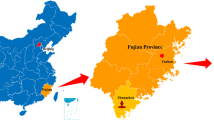Summary
The relation between remanent magnetization and volumetric strain for gabbro samples stressed in uniaxial compression inside a near zero-field μ-metal shield has been examined. For samples with an induced IRM parallel to the axis of compression, remanent magnetization decreased linearly up to the onset of dilatancy. As increased stress produced additional dilatancy, the variation of remanent magnetization became nonlinear, and the stress dependence continually decreased until the rock failed. Stress cycling with the peak stress augmented for each cycle produced a continuous decrease in the zero stress value of the IRM although an appreciable amount of recovery was observed during unloading. When the sample was loaded in constant stress increments after the onset of dilatancy and held for several minutes at each level, time-dependent variations in remanent magnetization coincided with time-dependent increases in inelastic volumetric strain. In general as the inelastic creep rate increases, the rate of change in remanent magnetization increases. These results suggest that dilatancy related effects of the intensity of rock magnetization should be observed in magnetic rocks in epicentral regions prior to earthquakes and may serve as both long- and short-term precursors.
Similar content being viewed by others
References
W. F. Brace, B. W. Paulding, Jr. andC. Scholz,Dilatancy in the fracture of crystalline rocks, J. Geophys. Res.71 (1966), 3939.
B. T. Brady,Theory of earthquakes, Part I, A scale independent theory of rock failure, Pure and Appl. Geophys., this issue, 1975.
R. L. Castle, J. N. Alt, J. C. Savage andG. I. Balazs,Elevation changes preceding the San Fernando earthquake of February 9, 1971, Geology2 (1974), 61.
U. Chandra,Seismicity, earthquake mechanisms, and tectonics along the Western Coast of North America from 42° N to 61° N, Bull. Seism. Soc. Am.64 (1974), 1529.
Department of the Environment, Ottawa, Canada,Monthly and yearly mean water levels, Marine Environmental Data Service, Ottawa.
T. C. Hanks,Constraints on the dilatancy-diffusion model of the earthquake mechanism, J. Geophys. Res.79 (1974), 3023.
S. D. Hicks andW. Shofnos,The determination of land emergence from sea level observations in South East Alaska, J. Geophys. Res.70 (1965), 3315.
S. D. Hicks andJ. E. Crosby,Trends and variability of yearly mean sea level 1893–1972 (NOAA Technical Memorandum NOS13 National Ocean Survey 1974.
J. A. Hileman, C. R. Allen andJ. M. Nordquist,Seismicity of the Southern California region, 1 January 1932 to 31 December 1972 (Seismological Laboratory, California Institute of Technology 1973.
C. Kisslinger,Processes during the Matsushiro earthquake swarm as revealed by leveling, gravity, and spring-flow observations, Geology2, in press.
A. Nur,Dilatancy, pore fluids and premonitory variations of t s /t p travel times, Bull. Seism. Soc. Am. 62 (1972), 1217–1222.
A. Nur,Matsushiro, Japan, earthquake swarm: Confirmation of the dilatancy-fluid flow model, Geology2 (1974), 217.
O. W. Nuttli,The western Washington earthquakes of April 13, 1949, Bull. Seism. Soc. Am.42 (1952), 21.
H. F. Reid,The mechanics of the earthquake, volume II of the report of the state earthquake investigation commission on the California earthquake of 1906 (Carnegie Institute, Washington 1910).
O. Reynolds,Dilatancy, Nature33 (1886), 429.
C. H. Scholz, L. R. Sykes andY. P. Aggarwal,The physical basis for earthquake prediction, Science181 (1973), 803.
C. H. Scholz,Post-earthquake dilatancy recovery, Geology2 (1974), 551.
W. Stauder,The Alaska earthquake of July 10, 1958: Seismic studies, Bull. Seism. Soc. Am.50 (1960), 293.
W. D. Stuart andM. J. S. Johnston (1974), personal communication.
L. R. Sykes,Aftershock zones of great earthquakes, seismicity gaps, and earthquake prediction for Alaska and the Aleutians, J. Geophys. Res.76 (1971), 8021.
D. Tocher,The Alaska earthquake of July 10, 1958, Bull. Seism. Soc. Am.50 (1960a), 217.
D. Tocher,The Alaska earthquake of July 10, 1958: Movement on the Fairweather fault and field investigation of southern epicentral region, Bull. Seism. Soc. Am.50 (1960b), 267.
S. Yamaguti,On the changes in the heights of yearly mean sea levels preceding the great earthquakes, Bull. Earthq. Res. Inst.46 (1968), 1269–1273.
J. H. Whitcomb, J. D. Garmany andD. L. Anderson:Earthquake prediction: variation of seismic velocities before the San Fernando earthquake, Science180 (1973), 632.
M. Wyss,Sea level, magnetic field, and P-residuals before the Sitka earthquake 1972, Pure Appl. Geophys., this issue, 1975.
Author information
Authors and Affiliations
Rights and permissions
About this article
Cite this article
Martin, R.J., Wyss, M. Magnetism of rocks and volumetric strain in uniaxial failure tests. PAGEOPH 113, 107–118 (1975). https://doi.org/10.1007/BF01592903
Received:
Issue Date:
DOI: https://doi.org/10.1007/BF01592903




